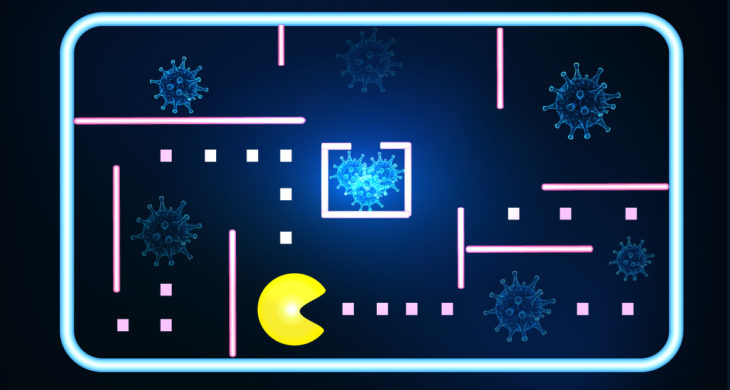
Date: 24th April 2020
The current COVID-19 pandemic has driven research into the repurposing of existing drugs. However, whilst this may meet our existing needs for expediting speedy treatments, it may not be the best long term strategy for finding the most effective treatments. Now scientists have developed a CRISPR-Cas13-based approach, PAC-MAN (Prophylactic Antiviral CRISPR in huMAN cells), as a potentially pan-coronavirus antiviral which includes inhibition of SARS-CoV-2.
Although the world’s scientists have mobilised in an effort to develop SARS-CoV-2 vaccines and pharmacologic treatments, as yet none have been proven or approved. Coronaviruses have a moderate mutation rate and, with the extent of the current outbreak, several different strains have emerged. This is crucial to understand in terms of developing diagnostics, vaccines and antiviral therapies.
As far as scientists can tell so far, there are currently three major strains, with a further three additional strains potentially emerging. Now researchers led by (Lei) Stanley Qi from Stanford University, US, have developed a pan-coronavirus strategy that targets more than 90% of all coronaviruses in efforts to create a one-treatment-fits-all antiviral strategy thereby circumventing viral evolution.
The team developed their PAC-MAN strategy as a form of genetic intervention to target SARS-CoV-2, Influenza A virus (IAV), and potentially all coronaviruses. PAC-MAN utilised the CRISPR-Cas13d system which is an RNA-guided RNA endonuclease, and which employs CRISPR-associated RNAs (crRNAs) to direct the Cas13d protein to specific RNA molecules for targeted RNA degradation.
SARS-CoV-2
The team initially created a bioinformatic pipeline to define highly conserved regions across many sequenced SARS-CoV-2 genomes. Two of the more highly-conserved regions contained the RNA-dependent RNA polymerase (RdRP) gene and the Nucleocapsid (N) gene which encodes the capsid protein for viral packaging. These regions were then targeted using CRISPR-Cas13d for viral sequence degradation.
40 crRNAs were designed, and tested in pools of 4, in human lung epithelial cells; which are representative of those infected by SARS-CoV-2 in patients. The team created fluorescent reporters which expressed synthesised fragments of SARS-CoV-2 conjugated to GFP, as live SARS-CoV-2 strains were unavailable at the time.
When tested, the highest-performing 3 cRNA pools could repress their reporters by between 60-71%. By changing the pools of crRNAs, to create crRNAs tiled along the length of the SARS-CoV-2 targeted fragment the efficiency rose up to 81% for RdRP and 90% for N.
Overall, the data suggests that Cas13d PAC-MAN could be an effective system to target and degrade SARS-CoV-2 sequences in human cells and the proper design of crRNAs is key to obtain highly efficient SARS-CoV-2 inhibition.
Influenza A virus
Whilst these results were promising, the lack of live strains meant that the system could not fully be tested. In order to achieve this the team turned to using the system to inhibit a live strain of IAV (previously engineered to express a fluorescent reporter protein). In a similar approach, described above, the team created crRNAs targeting a broad range of IAV strains. The bioinformatics analysis resulted in pools of 6 crRNAs targeting highly conserved genome regions for 8 IAV conserved segments.
Out of all crRNAs, the crRNA pool targeting the neuraminidase (NA) gene (required for the release of budding virions from the host cell), delivered the most consistent and robust results, showing up to 72% reduction in reporter expression.
Bioinformatic analysis of all coronavirus genomes
Further bioinformatics analysis suggested that a minimal group of 6 crRNAs could target 92% of IAV genomes. Encouraged that very few crRNAs could potentially target all sequenced IAVs, the group then went on to analyse all coronaviruses in a similar way.
Indeed, just two crRNAs could potentially target ~50% of coronavirus genomes, including those causing COVID-19, SARS, and MERS; 6 crRNAs were able to target ~91% of coronavirus genomes; and 22 crRNAs covered all sequenced coronaviruses with no mismatches.
This bioinformatic data highlighted the unique power of this method in developing pan-coronavirus strategies. On closer inspection of the different strains of SARS-Cov-2 (at the time only 2) both could be targeted with this minimal 6 cRNA approach.
Conclusions and future applications:
The work presented here in Cell, demonstrates that the PAC-MAN strategy could effectively repurpose the RNA-guided RNA endonuclease activity of Cas13d in human cells against viral targets. The system could target and cleave the RNA sequences of SARS-CoV-2 fragments and IAV with properly designed crRNAs in lung epithelial cells. The bioinformatics analysis here suggested that a minimal pool of 6 crRNAs would be able to target 91% of all currently sequenced coronavirus.
This would extend the applications of CRISPR-Cas13 systems beyond diagnostics, such as SHERLOCK, and live-cell RNA imaging. Whilst this is not the first Cas13 antiviral system to be developed - we reported on CARVER (CARVER: Cas-13-assisted restriction of viral expression and readout) an end-to-end platform that uses Cas13 to detect and destroy viral RNA at the end of last year - this is still a nascent field and, with Cas13 being relatively new to the scene, more extensive characterisation is needed for this tech.
What the authors establish well here is the potential for pan-treatments and, in contrast to traditional pharmaceutical or vaccination approaches, it is much less likely for the virus to escape inhibition through mutation offering us an exciting prospect for disease control.
Whilst this may offer us a big step forward in coronavirus strategy, there are of course several rather large caveats to PAC-MANs use. The first being that it has yet to be used on live SARS-CoV-2 strains. However, the team do acknowledge this is currently a proof-of-concept antiviral strategy. Whilst the ability to target so many coronaviruses with only 6 crRNAs is encouraging, only 1 was tested here, it is likely that the others will be tested in the coming months.
One major hurdle to climb will be the safe delivery of the system into human patients. We reported recently scientists from the University of Iowa and Feldan Therapeutics have engineered ‘shuttle’ peptides that could deliver Cas12a and Cas9 RNPs into the airway epithelial cells of mice via an aerosol. Aerosolised transfer of PAC-MAN would be ideal as it would target the cells that the virus also targets.
Here the team have tested the PAC-MAN system as a prophylactic system that was introduced before viral challenge. Two crucial steps looking forward will to be determine whether the system is effective as a post-infection treatment and how it translates in vivo.
With only a handful of CRISPRs clinical trials currently approved, first patient data appears promising but mixed. None of the current trials address CRISPR-based system as antivirals and with a long list of challenges to overcome this tech is a long-way off being a viable therapeutic for this current pandemic.
However, if this current outbreak has taught us anything is that we should be better prepared for the next one. With vaccines often taking years to develop, our investment into finding alternative solutions now may be crucial in being one-step ahead of the next viral threat.
This article is currently peer-reviewed but in pre-proof stages in Cell. A preprint version was previously published in bioRxiv.
DOI: 10.1016/j.cell.2020.04.020


